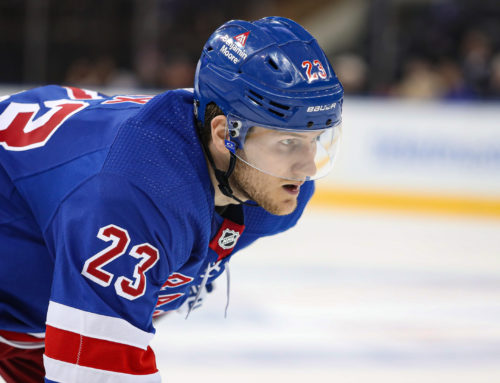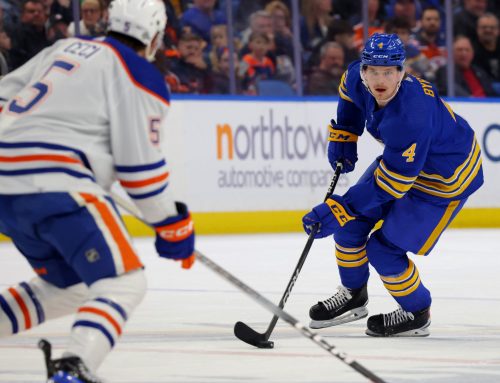
The Pittsburgh Penguins cleared some cap space by making a trade with Buffalo on Wednesday. Forward Conor Sheary and defenceman Matt Hunwick were sent to the Sabres in return for a conditional 2019 fourth-round pick.
This trade leaves the Penguins with about $8.1-million or so in cap space with only Jamie Oleksiak left to sign after they signed Riley Sheahan to $2.1-million yesterday. Assuming Daniel Sprong is the 12th forward added to the current roster, and depending what Oleksiak’s contract, this now leaves the Penguins with about $6-million to add one more forward. Enough room for, say, a Max Pacioretty or Jeff Skinner. Reports are that they cleared the cap space for Jack Johnson. We’ll see what they decide to do.
Anyway, this gives Buffalo a player they can slot into their top-6. With Evander Kane gone, their left-wing depth took a big hit. Evan Rodrigues is a fine player but he’s not a guy you want on your first line.
First thing about Sheary: he can finish. Across three seasons spanning 184 games and 300 shots on goal at five-on-five, he’s converted at a 12.6 percent clip. That’s a very, very good scoring rate.
Now, I understand the urge to say, “it was all because of Sidney Crosby.” Playing with Crosby should help anyone. All the same, I would like those people to explain why Sheary performed so much better playing with Crosby than Patric Hornqvist did:
I'm sure some will say Sheary "just played with Crosby" but if we look at that line last season (Crosby, Sheary, Hornvist), we see it was mostly Crosby and Sheary doing work. Botterill would be bringing him here to play with Eichel/Reinhart. You need skill to play with skill. pic.twitter.com/zzz65zuHUo
— Ryan Stimson (@RK_Stimp) June 27, 2018
There’s also the cap hit. Sheary is only due $3-million over each of the next two seasons. Unless the Sabres go wild in free agency, they won’t be a cap team this year. They may not be a cap team in 2018-19, either. You can argue he prevents a prospect from taking the top-line left wing slot, but it won’t limit them from bringing someone else in. They can do so if they feel so inclined.
Adding Sheary gives the Sabres a winger who’s shown he’s capable of not only playing with an elite centre but producing with an elite centre. That’s exactly what Jack Eichel needs. I doubt Sheary sees significant power-play minutes so anything more than a 20-goal, 50-point campaign is too optimistic, but it does give them a guy to play with their franchise pivot while sheltering the younger guys in the lineup without significant cap implications. That’s a win for the Sabres.
*
Something that fantasy owners are guilty of – present company included – is assuming because a change occurred that this change is the new norm. This presumption can take many forms but one of the instances this occurs most often is with goaltending. Because an established, successful goalie has one bad year, or an established unsuccessful goalie has one good year, the presumption is often that this outlier season is the new standard.
Another instance this occurs is with scoring. Fantasy owners have gotten wiser to shooting percentage binges but there are still other factors to consider when determining if an improvement in an offensive category is on-ice Corsi For.
Remember that on-ice Corsi For (CF) is the number or rate of shot attempts a team takes with a given player on the ice, not the actual shot attempts of a given player. Josh Bailey had an on-ice CF/60 minutes at five-on-five of 56.45 in 2017-18, which means the Islanders took an average of 56.45 shot attempts per 60 minutes at five-on-five with Bailey on the ice.
It’s clear why CF/60 is important: more shots mean more opportunities to score. More opportunities to score mean more opportunities for points. Clear as mud? Good.
It’s worth going through players with significant CF/60 increases in the 2017-18 season. Keep in mind that about six weeks ago we discussed in these Ramblings how shot rates increased across the league by a little over four percent.
Decreases will be covered in the next Ramblings.
Below we’ll discuss a few of these players and whether a new norm may be established or if it’s just a blip. These are forwards who managed at least 500 minutes of ice time in both 2016-17 and 2017-18, and it’s at five-on-five. All data from Natural Stat Trick. I will be using viz from CJ Turtoro based on data from Corey Sznajder as well.
These are the top-25 biggest increases in on-ice CF/60 from 2016-17 to 2017-18.

Let’s dig in.
Though he had just 30 total points, it was a breakout season of sorts for Anderson. He managed 19 goals in just 63 games, outscoring his 2016-17 season in 15 fewer games. A big part of this is not only his increase in shot rate – his personal shot rate at five-on-five went up over 30 percent – but we saw the progression of a young player growing into a potential star:

That viz shows us how much he’s improving in things that lead to an increase in offence like controlled zone entries, controlled zone exits, shot assists (passes that lead directly to shots), and his personal shot rate. Everything moved in the right direction for Anderson last year but he was slowed by three things: injury, line mates’ inability to score, and inconsistent lineup placement. Remember he was a fixture of the top line with Artemi Panarin and Pierre-Luc Dubois before he was replaced by Cam Atkinson.
Ah, Artemi Panarin. Let’s talk about that.
There’s no doubting that playing with Panarin helped Anderson. While he skated with Panarin, Anderson’s on-ice CF/60 was 73.02, which is outstanding. When he was on the ice without Panarin, that number was plummeted to 57.26. Here’s the thing: that rate of 57.26 shot attempts/60 minutes is still an increase of 12.8 percent over his 2016-17 season, a significant increase even when factoring in a baked-in league-wide rise in shot rates (remember that number was about 4.1 percent). Yes, obviously playing with one of the most skilled players on the planet will help a lot, but he still showed significant improvement without him.
The question of Anderson’s production next season will depend on his teammates rebounding from poor shooting percentages; he shot 9.43 percent at five-on-five, which is good, but the team shot 6.79 percent with him on the ice, which is bad. Just a full season at his 2017-18 level could see 25 goals next year. His assist rate will rely on guys like Oliver Bjorkstrand, Boone Jenner, and Brandon Dubinsky turning things around personally.
Interesting times in Sunrise. After flubbing the expansion draft to epic proportions, they acquired Mike Hoffman recently to help fill the lack of scoring in the lineup. I say ‘lack of scoring’ in the sense that their top-6 did all the heavy lifting. Cup contenders need three lines to score (four would be better) and adding Hoffman enables the team to lengthen the lineup, whether Hoffman’s in the top-6 or not.
Let’s not forget about Bjugstad though. He averaged just 39 points through his first four full seasons, maxing out at 43 in 2014-15, before posting his 49-point campaign in 2017-18. He has three years left at $4.1-million per season, and if he can repeat 50 points for those three years, the team will get good value out of the back end of that contract.
While it had been tried out infrequently earlier in the year, the trio of Bjugstad, Aleksander Barkov, and Evgney Dadonov was united pretty much for good on January 25th. After that point, Bjugstad played about 75 percent of his minutes at five-on-five with exactly those two players, and about 82 percent of his time with at least one of those two, if not both. Before January 25th, his on-ice CF/60 was 59.38 but jumped to 69.27 when skating on the top line after January 25th. His CF/60 in 2016-17 was 50.33. In that sense, he’s kind of like Anderson: even though he on-ice shot rates declined when he wasn’t on the top line, his shot rate still increased significantly above the league average, about 18 percent.
The bulk of Bjugstad’s production came in that second half when he was one the top line, scoring 27 points in 36 games. Up to that point, he had 22 points in 46 games.
How they decide to use Bjugstad next year will be crucial. He can still put up good peripheral numbers even without the points; he had 95 hits, 41 PIMs, and 230 shots last year and has topped 100 hits, 200 shots, or 40 PIMs twice each in his career. But whether he can produce goals and assists at a rate necessary for value in leagues that don’t count all, or some, of those stats will depend on whether he returns to the top line or not.
I’ve been a Zacha fan since my very limited viewership of him back in his Sarnia days so when he was chosen sixth overall in 2015, my hope was that he would be the centre of the future the Devils needed. Once they traded for Taylor Hall? Hoo boy.
Things haven’t worked out exactly as hoped for Zacha. He has 49 points total through his first two full seasons (139 games) and has been bounced all around the lineup, including being sent to the press box at times in 2017-18. Not a great start.
There is hope, though.
Zacha didn’t play all that often with Taylor Hall; out of his 802 five-on-five minutes, Zacha skated with the MVP for a little over 101 minutes. His on-ice CF/60 wasn’t much better with Hall, about 6.7 percent, which isn’t far above just the general increase league-wide. That’s why it’s heartening to see him on the list of biggest on-ice CF/60 increases. Even discounting his ice time with Hall, his on-ice CF/60 went up over 19 percent. If you look at his time on ice without Hall in both 2016-17 and 2017-18, his on-ice CF/60 went up a whopping 25.9 percent. Compared to the league rate of 4.1 percent, and New Jersey’s own increase in team rate of 12.3 percent, Zacha’s 2017-18 season showed a lot of promise, even if the raw point totals don’t show it.
Much like Anderson, Zacha saw an increase in the things we know lead to more shots and goals, pretty much across the board, from 2016-17 to 2017-18:

In sum, Zacha’s personal shot attempt rate at five-on-five increased a monster 41.6 percent, his on-ice shot attempt rates both with and without Taylor Hall increased significantly more than both the league rate and the team’s rate, and the underlying numbers to support such increases are there. Again, the raw point totals weren’t good, but everything that can lead to points showed improvement, sometimes by a lot.
Like many others, it’s a question of role. Do they play him at centre or wing? Top-6 or third line? Top PP unit or not? Are the Devils going to add more scoring, either via trade or free agency? There are a lot of variables yet to be determined but all the same, don’t lose sight of this: Zacha took the necessary steps forward in 2017-18 to being fantasy-relevant in the next couple of years. Things didn’t look that way even 10 months ago.





 FLA
FLA CHI
CHI NYR
NYR PIT
PIT L.A
L.A COL
COL MTL
MTL ANA
ANA STL
STL N.J
N.J VAN
VAN PHI
PHI
